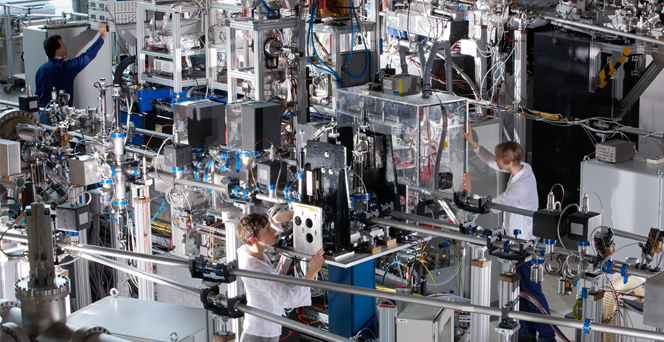URL: https://www.desy.de/research/facilities__projects/flash/index_eng.html
Breadcrumb Navigation

FLASH
Free-electron laser FLASH
Since 2005, the world’s first free-electron laser in the X-ray range, FLASH at DESY in Hamburg, has been generating a very special kind of light: extremely intense, ultrashort-pulse X-ray laser flashes. Researchers from all over the world are using them to observe the movements of atoms and molecules.
FLASH accelerates electrons to almost the speed of light. Special arrangements of magnets, called “undulators”, then force the electrons to move along a slalom course. In the curves, the fast particles emit short flashes of X-rays. These flashes overlap and oscillate in sync to create incredibly intense and short X-ray flashes on a time scale of femtoseconds – in other words, quadrillionths of a second. These flashes make it possible, for example, to film chemical reactions, which also take place at femtosecond speeds. FLASH is the pioneering light source at which important foundations for creating movies of the nanocosmos have been investigated.
Filming chemical reactions
To observe the details of a chemical reaction, researchers first take a huge number of individual images until they have recorded all of the stages of the reaction. Arranging these images in sequence creates a “movie” that shows the process at the molecular level. With X-ray lasers such as FLASH, scientists can observe what actually happens at the level of atoms and molecules and use this information to develop new materials and drugs.
TESLA accelerator technology
A distinguishing feature of FLASH is the use of superconducting accelerator technology to propel the electrons to the required high energy. This pioneering technology was developed by DESY together with 50 institutes from 12 countries within the international TESLA Technology Collaboration. Unlike conventional devices, the TESLA accelerator elements – the cavities – are superconducting: Cooled to minus 271 degrees Celsius, they conduct electric current loss-free so that practically all of the electric power they consume can be transferred to the particles – an extremely efficient acceleration method. What’s more, the superconducting cavities deliver a very thin and homogeneous electron beam of extremely high quality. A particle beam with such special properties is a prerequisite to operate a free-electron laser in the X-ray range.
Free-electron lasers – the principle
In a free-electron laser, the special X-ray laser light is produced based on a sophisticated principle: During their slalom run through a periodic array of magnets (the undulator), the electron bunches emit radiation (photons) of a distinct wavelength. The photon beam propagates in a straight line and overlaps with the electron bunch. It imprints its periodic structure on the electron bunch so that the initially homogeneous electron charge density distribution becomes periodic – a chain of tiny individual charge “disks” regularly separated by a single wavelength. Now all the electron disks emit radiation in synchrony, and the light can amplify to form high-intensity laser radiation.
Upgrade for the future
The international research community is tremendously interested in FLASH. That is why the facility was expanded and a second tunnel section including an experimental hall with space for six measuring stations was added. This expansion more than doubled the user capacity of FLASH, meeting the high demand. The two beamlines can be operated in parallel, with largely independently adjustable wavelengths.
Since 2020, as part of the FLASH2020+ project, the wavelength of the X-ray laser light is being further shortened and the beam quality and experimental conditions are being optimised to ensure the facility’s top position as an X-ray laser pioneer and forerunner for innovative technologies in the future.
- Free-electron laser (FEL) with superconducting linear accelerator in TESLA technology
- Length: 315 metres
- Generates extremely brilliant laser radiation in the vacuum ultraviolet and soft X-ray range using the SASE principle
- 1992–2005: Test facility for superconducting TESLA accelerator technology and FEL technology
- Since 2005: FEL facility for photon science
- Five measuring stations in experimental hall “Albert Einstein”
- Space for six measuring stations in experimental hall “Kai Siegbahn”


